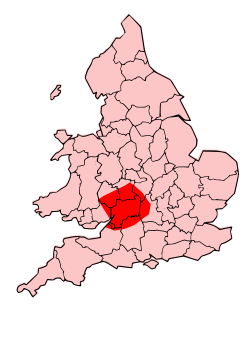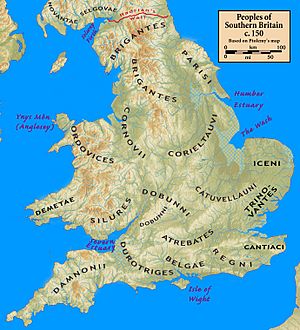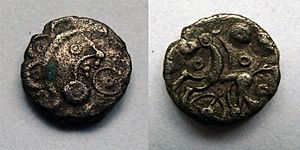Dobunni facts for kids
Quick facts for kids Dobunni |
|
 |
|
| Geography | |
| Capital | Corinium Dobunnorum (Cirencester) |
|---|---|
| Location | West Oxfordshire Gloucestershire Monmouthshire North Somerset Bristol South Herefordshire Warwickshire Wiltshire Worcester Breconshire |
| Rulers | Anted[...], Eisu[...], Catti[...], Comux, Inam[...], Corio[...], Boduoc[...] |
The Dobunni were an ancient tribe who lived in the Iron Age in what is now Britain. They lived before the Romans arrived and took over the land. We know about them from seven mentions in old Roman writings and inscriptions.
Some experts think their name might come from a word meaning "cup" or "vessel." Others suggest their original name was "Bodunni," which could mean "The Victorious Ones" in an old Celtic language.
Contents
Where did the Dobunni live?
The Dobunni tribe lived in central Britain. This area is now mostly the English counties of Bristol, Gloucestershire, and northern Somerset. Sometimes, their land might have also reached into parts of Herefordshire, Oxfordshire, Wiltshire, Worcestershire, and Warwickshire.
Their main town was called Corinium Dobunnorum by the Romans. Today, this town is known as Cirencester.
Their land was surrounded by other tribes. To the north were the Cornovii and Corieltauvi. The Catuvellauni were to the east. To the south were the Atrebates and Belgae. The Silures and Ordovices lived to the west.
Life in the Iron Age
The Dobunni were mostly farmers and skilled craftspeople. They lived in small villages, often located in fertile valleys.
They built strong, fortified camps called hillforts. You can still see the remains of some of these in the Bristol area. Examples include Maes Knoll, Clifton Down, Burwalls, and Stokeleigh. These hillforts often overlooked the Avon Gorge. Other sites are at Kingsweston Down and Blaise Castle.
Later in the Iron Age, some larger settlements, known as oppida (which means "towns"), started to appear. One such site was at Bagendon, near Cirencester. However, other big sites like Salmonsbury were also important.
The Dobunni and the Romans
When the Romans invaded Britain in AD 43, the Dobunni were different from some of their neighbours. They were not a warlike tribe. They surrendered to the Romans even before the Roman army reached their lands.
This meant they quickly adopted the Romano-British way of life. They became part of the Roman Empire.
Their territory was later divided into Roman political areas. One was a civitas, which was a self-governing area centered in Cirencester. The other was a Colonia in Gloucester, which was a Roman settlement for retired soldiers. This Colonia was set up around AD 96–98.
By the early 4th century, Britain was divided into several Roman provinces. The Dobunni's land was in a province called Britannia Prima. The area remained a Roman civitas until about 409 AD.
The Dobunni territory had two large towns: Cirencester (Corinium Dobunnorum) and Gloucester (Colonia Nerviana Glevum). There were also many smaller towns and rich country homes called villas.
The Dobunni people also had their own beliefs and gods. They often worshipped nature, like rivers and hills. For example, they worshipped a mother goddess named Cuda, linked to the Cotswold Hills. They also worshipped Sulis Minerva at Bath. Other gods were connected to activities like mining or hunting.
After the Romans left
After the Roman government in Britain collapsed, the Dobunni area kept its identity for a while. This lasted until the Battle of Deorham in 577 AD. In this battle, the Saxons moved into the area, reaching the River Severn.
However, about 50 years later, these gains were reversed. Penda of Mercia fought the West Saxons at the Battle of Cirencester. The Dobunni area then came under the control of Mercia, becoming a smaller kingdom called the Hwicce. Some historians think this area kept its Christian identity, perhaps as a reward for helping Mercia against the West Saxons. This suggests a link between the old Dobunni area and the new Hwicce kingdom.
Dobunni coins
The Dobunni were one of the tribes who made their own coins before the Romans arrived. These coins tell us a lot about their rulers. The coins suggest that the Dobunni kings sometimes divided their land into northern and southern parts. Other times, the land was ruled by a single king.
A common design on Dobunni coins is a branched symbol. We don't know exactly what this symbol means. Some ideas are that it represents corn, ferns, or a type of wreath.
Images for kids
See also
List of Celtic tribes




